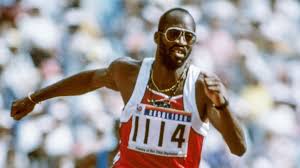In the annals of sports history, there are athletes who win, and then there are those who transform the game itself. Edwin Moses belongs firmly in the second category. A two-time Olympic gold medalist and an undefeated force for nearly a decade, Moses didn’t just dominate the 400-meter hurdles he rewrote the rulebook on how it was run and set new standards for professionalism, ethics, and innovation in track and field.
The Making of a Champion
Born in Dayton, Ohio, in 1955, Edwin Corley Moses was far from the typical high school sports prodigy. He attended a historically Black college, Morehouse College in Atlanta, where there was no track. Instead, he trained on public high school facilities, balancing his rigorous studies in physics and engineering with his emerging athletic career. This unique combination of intellect and discipline would later become one of his greatest competitive advantages.
Initially a decathlete, Moses eventually focused on the 400-meter hurdles an event combining speed, stamina, and precision. In just his third race over hurdles, he qualified for the 1976 Montreal Olympics. There, at just 20 years old, he stunned the world by not only winning gold but breaking the world record with a time of 47.64 seconds. It was a sign of things to come.
The Streak: A Decade of Dominance
After Montreal, Moses entered what is arguably the most dominant stretch in the history of athletics. From 1977 to 1987, he went unbeaten in 122 consecutive races, including 107 finals. For over nine years, nine months, and nine days, not a single athlete crossed the finish line ahead of him.
What made Moses so unbeatable wasn’t just physical ability it was his strategic brilliance. Most hurdlers used inconsistent stride patterns between hurdles, often varying between 13 and 15 steps. Moses committed to a consistent 13-step pattern, using his long legs and perfect timing to glide over hurdles with unmatched efficiency. This rhythmic mastery disrupted the traditional approach and became the gold standard for future generations.
Innovation On and Off the Track
Edwin Moses wasn’t content to only be an athletic icon; he wanted to elevate the sport itself. With his background in science, he applied a methodical, data-driven approach to his training and performance. Every aspect from his stride mechanics to breathing control was calculated, refined, and executed with precision.
Off the track, he became a pioneer in athlete advocacy and anti-doping efforts. In the 1980s, Moses played a key role in the development of one of the first random, out-of-competition drug testing programs. He chaired the U.S. Olympic Committee’s Substance Abuse and Education Program and later became involved with the Lausanne-based World Olympians Association. His goal was clear: to protect the integrity of sport and the health of its athletes.
Legacy Beyond Medals
After a U.S. boycott of the 1980 Moscow Olympics (where he was heavily favored to win gold), Moses returned triumphantly at the 1984 Los Angeles Games, winning his second Olympic gold in front of a home crowd. He continued to compete at the highest level, earning a bronze medal in Seoul in 1988 at age 33 long after most hurdlers had retired.
But perhaps Moses’s greatest impact is in the legacy he left. His combination of academic intelligence, athletic prowess, and moral leadership helped redefine what it means to be a professional athlete. He proved that sport could be a platform not just for personal glory, but for systemic change.
A Blueprint for Greatness
Edwin Moses changed the game by being more than fast he was precise, principled, and forward-thinking. He showed that athletic excellence can be achieved through science, discipline, and integrity. His unbeaten streak remains one of the most awe-inspiring records in all of sports, but even more impressive is how he used his platform to advocate for fairness, transparency, and athlete welfare.
In today’s sports landscape, where talent is often matched by media hype and controversy, Edwin Moses stands as a timeless example of what true greatness looks like: humble, intelligent, and unstoppable.

